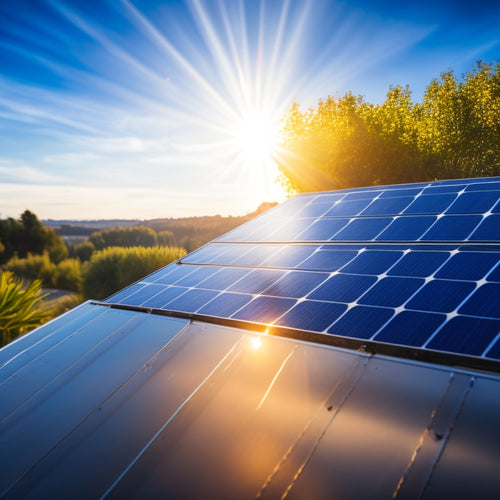Cost of Battery Storage for Solar Panels
Share
You can expect to pay between $5,000 and $15,000 or more for a solar battery storage system, depending on the type and size of the batteries, as well as the overall energy storage needs of your solar panel setup. The cost of battery storage is largely driven by the type of deep cycle battery you choose, with lithium-ion batteries offering higher efficiency and longer lifetimes, but at a higher upfront cost. Lead-acid batteries, on the other hand, are more budget-friendly but have limited lifecycles. To get the most value out of your investment, it's important to carefully consider your energy needs, battery capacity, and cycle life expectancy - and that's just the beginning of your exploration into the world of solar battery storage.
The Essentials
- The cost of battery storage for solar panels depends on the type and chemistry of the battery, with lithium-ion being more expensive than lead-acid.
- A deeper understanding of battery technology and chemistry is crucial in selecting the right battery for solar panel systems, balancing cost and efficiency.
- The cycle life expectancy of a battery significantly impacts the overall investment value, with higher cycle life leading to better cost-effectiveness over time.
- Battery capacity and size considerations are critical, as larger batteries offer more storage but at higher prices, while smaller batteries may be insufficient for high demand.
- Effective energy management is essential to optimize battery performance, adjusting discharge levels to balance usable energy and lifespan.
Increased Energy Independence Guaranteed
You'll enjoy a higher degree of energy independence with solar panels and battery storage, as you'll be generating your own renewable energy source. This means you'll reduce your reliance on the grid, giving you more control over your energy usage and costs.
By implementing a home battery storage system, you can solve three major problems - reducing your reliance on the grid during power outages, lowering your electricity bills, and shaving peak demand charges.
With a battery storage system, you can store excess energy generated during the day for use during the night or on cloudy days, further decreasing your dependence on external power sources.
Renewable Energy Source
With the ability to capture energy from the sun, solar panels offer a renewable energy source that reduces reliance on fossil fuels and mitigates climate change. By utilizing this clean energy, you'll contribute to sustainable development and reduce your environmental impact.
Solar panels promote energy efficiency by converting sunlight into electricity, minimizing the need for power generation from non-renewable sources. With advanced battery systems, such as solar panel batteries, you can store excess energy generated during the day for use during the night or on cloudy days, ensuring a continuous power supply.
As technology advancements continue, future innovations in solar energy will further decrease your reliance on the grid. Policy implications will also play a significant role in shaping the market trends and investment opportunities in the renewable energy sector.
Community initiatives, such as solar cooperatives, will emerge, enabling individuals to pool their resources and invest in solar infrastructure.
You'll be at the forefront of a movement that prioritizes freedom from fossil fuels and promotes a cleaner, healthier environment. As the demand for renewable energy grows, you'll benefit from decreased energy costs and a reduced carbon footprint.
Reduced Grid Reliance
By reducing your reliance on the grid, you gain increased energy independence, ensuring a consistent power supply even when the grid is down. This freedom from grid dependence is made possible by advancements in storage technology, which enables you to store excess energy generated by your solar panels during the day for use at night or during power outages.
With the ability to store excess energy generated by solar panels or other renewable sources, sustainable energy systems can also help reduce reliance on the grid, minimizing the environmental impact of traditional power consumption. Additionally, lithium-ion batteries, which are widely used in energy storage systems, have become more efficient and cost-effective over the years.
However, it's crucial to evaluate the installation costs, maintenance requirements, and environmental impact of battery storage systems. As market trends continue to shift towards renewable energy, the demand for energy storage solutions is increasing.
Reduced Peak Hour Draw
By installing a battery storage system for your solar panels, you'll reduce your peak hour draw from the grid, resulting in lower electricity bills.
This is because you'll be using stored energy instead of relying on the grid during peak hours when rates are highest.
With integrated solar panel energy storage solutions, you can maximize your renewable energy savings off grid solar systems and decrease your reliance on non-renewable energy sources.
As a result, you'll also decrease your dependence on the grid, further solidifying your energy independence.
Lower Electricity Bills
Your electricity bills shrink when you pair solar panels with battery storage, as the stored energy reduces your peak hour draw from the grid. This reduction in peak hour draw translates to lower electricity bills, providing you with energy savings that can be significant over time.
| Scenario | Peak Hour Draw (kWh) | Energy Savings (%) |
|---|---|---|
| Without Battery Storage | 5 | 0 |
| With Battery Storage (50% of peak hour draw) | 2.5 | 50 |
| With Battery Storage (75% of peak hour draw) | 1.25 | 75 |
| With Battery Storage (100% of peak hour draw) | 0 | 100 |
Reduced Grid Dependence
The stored energy in your battery storage system reduces your grid dependence during peak hours, a significant advantage of pairing solar panels with battery storage. This means you'll rely less on the grid when energy demand is highest, typically between 4 pm and 7 pm.
During these peak hours, the grid is often strained, leading to increased energy costs and a higher likelihood of power outages. By reducing your peak hour draw, you'll not only save on your electricity bills but also contribute to a more stable grid.
With a battery storage system, you can optimize your renewable integration by storing excess energy generated during the day for use during peak hours. This approach enhances battery efficiency, as it reduces the need for the battery to charge and discharge rapidly.
Deep Cycle Battery Types
You'll need to choose a deep cycle battery that suits your solar panel system's requirements, taking into account options like lead-acid, lithium-ion, and nickel-cadmium, each with its own chemistry advantages and limitations.
When selecting a deep cycle battery, it's crucial to evaluate the type of renewable energy system you have, as different batteries are better suited for off-grid homes or renewable energy systems Reliable Power Storage.
The cycle life expectancy of your chosen battery type will greatly impact its overall cost-effectiveness, as it determines how many charge and discharge cycles you can expect before replacement becomes necessary.
Battery Chemistry Options
Several deep cycle battery types are available, each with its unique chemistry and characteristics, catering to diverse solar panel storage needs.
You'll find that each battery type has its strengths and weaknesses, so it's crucial to comprehend the chemistry comparison to make an informed decision.
Lead-Acid batteries, for instance, offer a cost-effective solution with moderate performance metrics and efficiency ratings. They're a popular choice for off-grid systems, but their environmental impact is a concern due to the toxicity of lead.
On the other hand, Lithium-Ion batteries boast high efficiency ratings and a longer lifespan, making them a top pick for residential solar installations. However, their higher upfront cost and safety considerations, such as thermal runaway risks, need to be factored into your cost analysis.
Other battery types, like Nickel-Cadmium and Sodium-Ion, offer varying degrees of performance, efficiency, and environmental sustainability.
As you weigh your options, consider longevity factors, such as the number of charge cycles and overall lifespan, to guarantee you're getting the most out of your investment.
Cycle Life Expectancy
When evaluating deep cycle battery options for your solar panel storage, understanding the cycle life expectancy of each type is vital. Cycle life expectancy refers to the number of charge and discharge cycles a battery can handle before its capacity drops below 80% of its initial rating. This metric directly affects the overall cost of ownership, as a longer cycle life means fewer replacements are needed.
Here's a comparison of different deep cycle battery types and their cycle life expectancies:
| Battery Type | Cycle Life Expectancy |
| Lead-Acid (Flooded) | 200-300 cycles |
| Lead-Acid (AGM) | 300-500 cycles |
| Lithium-Ion (LiFePO4) | 2,000-3,000 cycles |
| Lithium-Ion (NMC) | 1,000-2,000 cycles |
To maximize cycle life, it is important to take into account factors like battery maintenance, performance monitoring, and energy management. Proper installation considerations, grid integration, and warranty terms also play a significant role. Additionally, evaluating environmental impact, recycling options, and cost trends can help you make an informed decision. By understanding the cycle life expectancy of different battery types, you can optimize your solar panel storage system for long-term performance and freedom from energy dependence.
Battery Capacity Matters Most
When you're selecting a battery for your solar panel system, you'll need to evaluate the capacity that best suits your energy needs, as well as the type of battery technology, such as lithium-ion or lead-acid, which can impact the overall cost and performance renewable energy storage.
You'll face a tradeoff between size and cost, as larger batteries provide more storage but come at a higher price.
The depth of discharge also matters, as it affects the battery's lifespan and overall performance.
Size and Cost Tradeoff
Picking the right size for your solar panel battery storage system can be a delicate balancing act, as it directly impacts the overall cost. You need to evaluate your energy efficiency goals, installation costs, and performance metrics to determine the ideal battery sizing for your system.
A larger battery capacity typically means higher upfront costs, but it also provides more energy storage and potentially better return on investment. On the other hand, a smaller battery capacity may be more budget-friendly, but it mightn't meet your energy needs during periods of high demand.
As you weigh the size and cost tradeoff, keep in mind the market trends and technology advancements in the industry. Advances in battery technology have led to improved energy density and reduced costs, making larger batteries more feasible.
Additionally, assess the environmental impact and maintenance expenses associated with your chosen battery size. By conducting a thorough cost analysis and evaluating these factors, you can strike the right balance between battery size and cost, ensuring a reliable and efficient solar panel battery storage system that meets your needs and budget.
Depth of Discharge Matters
As you've carefully considered the size and cost tradeoff for your solar panel battery storage system, you're now ready to focus on another critical aspect: the depth of discharge. This refers to the percentage of the battery's capacity that's actually used.
A deeper depth of discharge means you're utilizing more of the battery's capacity, but it can also reduce its lifespan. A shallower depth of discharge, on the other hand, increases the battery's efficiency and extends its lifespan, but it may not provide as much usable energy.
You'll need to strike a balance between these two factors. A good starting point is to aim for a depth of discharge between 50% and 80%. This allows you to utilize a significant amount of energy while still maintaining a reasonable battery lifespan.
Effective energy management is key to achieving this balance. By monitoring your energy usage and adjusting your depth of discharge accordingly, you can optimize your battery's performance and maximize its efficiency.
Lithium-Ion Beats Lead Acid
You'll find that lithium-ion batteries outperform lead acid batteries regarding cycle life, with up to 5,000 cycles compared to lead acid's 200-300 cycles.
This means lithium-ion batteries can last up to 15 years, while lead acid batteries need to be replaced every 5-7 years.
As a result, you'll save money and reduce maintenance needs by choosing lithium-ion batteries for your solar panel system.
Longer Cycle Life
One key advantage of lithium-ion batteries over lead acid batteries lies in their longer cycle life.
You'll get more bang for your buck with lithium-ion batteries, which can last up to 5,000 cycles or more, compared to lead acid batteries that typically max out at around 1,000 cycles.
This means you'll need to replace lead acid batteries more frequently, adding to their overall cost.
Lithium-ion batteries also require less battery maintenance, as they don't need to be equalized or vented like lead acid batteries do.
This reduced maintenance means you'll spend less time and money keeping your batteries in top shape.
Additionally, lithium-ion batteries have better recycling options, making them a more environmentally friendly choice.
With a longer cycle life and reduced maintenance needs, lithium-ion batteries are a cost-effective option for your solar panel system.
You'll enjoy a longer-lasting, low-maintenance energy storage solution that gives you the freedom to generate and store your own clean energy.
Frequently Asked Questions
How Long Does It Take to Fully Charge a Solar Battery?
You'll find that the time it takes to fully charge a solar battery depends on its capacity and the charging efficiency of your system, so you'll need to take into account these factors to determine the ideal charging time for your setup.
Can I Use My Solar Panels Without Battery Storage?
You can use your solar panels without battery storage, capturing energy directly during the day, but you'll sacrifice energy independence and rely on the grid at night; prioritize solar panel efficiency to maximize daytime production.
Are Solar Batteries Covered Under Warranty?
You'll be relieved to know that solar batteries are typically covered under warranty, which protects your investment by assuring a certain battery lifespan; review warranty details carefully to make certain you're aware of what's covered and for how long.
Can I Install Solar Batteries Myself?
You're considering DIY installation, but pause - can you guarantee battery safety? It's essential to weigh the risks, as improper connections can lead to electrical shocks, fires, or even explosions, putting your freedom and property at stake.
How Often Should I Maintain My Solar Battery System?
You should perform routine battery maintenance every 3-6 months to verify peak performance and extend your solar battery lifespan; follow battery maintenance tips like checking voltage, cleaning terminals, and updating software to secure maximum energy independence.
Final Thoughts
As you utilize the power of solar panels, battery storage is the key to releasing true energy freedom. With the right deep cycle battery, you'll break free from peak hour shackles and savor the sweet taste of independence. Lithium-ion's superior performance leaves lead acid in the dust, and capacity is the unsung hero that makes it all possible. So, invest wisely and watch your energy bills dwindle like a fading sunset, replaced by a bright, sustainable future.
Related Posts
-

How to Achieve a Zero-Waste Lifestyle for a Greener Tomorrow
To achieve a zero-waste lifestyle, start by adopting the principles of refusing, reducing, reusing, and recycling. Sw...
-

Diy Off Grid Solar
By embracing DIY off-grid solar, you can break free from grid dependence, slashing your energy bills by up to 90% and...
-

How Efficient Are Thin Film Solar Cells
Thin film solar cells provide an innovative approach to energy generation, boasting efficiency rates generally betwee...


